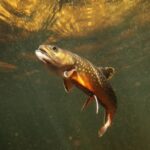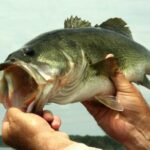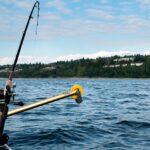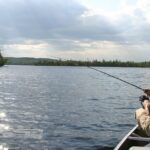Bass fishing is challenging for all anglers, which is why these fish are such a prized catch for sports fishing. Bass fishing is some of the most exciting, but if you do not know where to find the fish, they are impossible to catch. There is much conflicting information about how deep to fish for bass, leading many to wonder what the truth is about the ideal depth for bass fishing.
Bass can be found anywhere from 6 – 12 feet below the water’s surface. Larger bass are found deeper than smaller specimens. Bass swim deeper when the weather is hot or cold, and they come to the shallows at dawn, dusk, and when there is rain, as they will find more food in these conditions.
If you are new to bass fishing or if you want to catch bigger bass, it is critical to learn the depths to fish at. Bass are much less predictable than most other fish, and they are far less concerned about water depth and temperature than other fish are. This can make it difficult to find the ideal depth for bass fishing, but the process becomes far easier if you know what to look out for.
How Deep Should I Fish For Bass?
Bass fishing is unlike fishing for any other species of fish. Bass are intense predators that are very aggressive and can be very picky simultaneously. These fish are considered true sport fish simply because they are so difficult to catch, especially when targeting large specimens.
However, there are things you can do to make bass fishing more attainable, even if you are a beginner to the sport. Understanding the depths to fish for bass is among the most important aspects of successful bass fishing.
Bass are almost unique among freshwater fish. There are multiple species of bass, most of which share very similar traits and characteristics. Part of which is the depths that they swim at.
However, among the reasons why these fish are so difficult to catch is because they can be found at multiple depths depending on their gender, age, size, and the type of water they are in.
To make the situation worse, the biggest bass of all tend to ignore all depth characteristics and can be found in any depth of water, so long as there is sufficient food for them to survive on and keep gaining size.
Bass can be found at almost all depths in freshwater. The smallest of the species are found in the shallows or near the surface, especially small males in the spring and autumn. Larger bass can be found a little deeper below the surface. The females tend to venture a little deeper and regulate their temperature more frequently.
The largest of the species live as deep as 15+ feet in some instances, which means you can successfully catch bass at almost every depth.
There are several reports that say that bass cannot be caught if you fish too shallow, but this is not usually true unless the weather or water temperature is very cold.
Bass are not found at the waterbed, but you can find them from around the mid-depth to the water’s surface, provided you fish in the right locations.
A general rule for the depth of bass fishing is to try and stay within 6- 12 feet from the surface. You may need to fish at deeper depths for the largest fish when the weather is very hot or very cold, as the fish will retreat further underwater to regulate temperature, and you may find smaller bass well above 6ft, depending on where the food is.
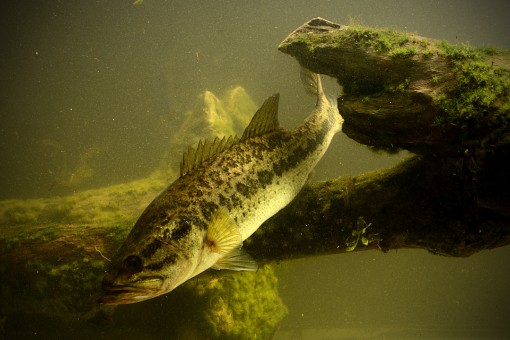
How To Find The Right Depth For Fishing Bass
The trouble with finding the right depth for bass fishing is that bass can be found at multiple depths. This means that new bass anglers that have not yet developed a good sense of where the fish may need to rely on some techniques and methods for finding the right depth when bass fishing.
There are several methods for finding the right depth for catching bass. Bass tend to be at different depths in different seasons and different bodies of water, so learn how to find the depth for these fish every time you go fishing at various sites.
Here are some of the very best methods for finding the right depth when bass fishing.
Consider The Size Of Bass You Are Catching
The first thing to do when determining the depth you want to fish is to consider the size of bass you want to catch and look at the size of the bass you have caught at that location already, provided you have been there before.
If you are catching nothing but small bass, try fishing a little lower. Where the small bass are, there are likely to be larger bass at a deeper depth.
If you aim for the largest bass specimens, start fishing at about 8 – 10 feet deep. Look for areas where the fish may be, and start with the lower depths, especially if the weather is temperate.
Look for the fish a little deeper than you may expect on very hot or cold days.
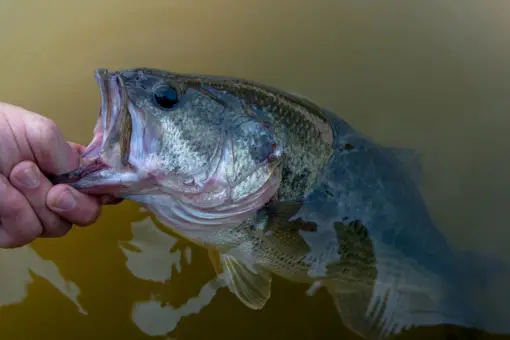
Try Multiple Depths
If you are fishing very unfamiliar waters or are trying bass fishing for the first time and struggling to find the fish, try fishing multiple depths in quick succession.
Spend 20 minutes fishing the shallower depths, and move progressively lower every time you cast after that.
Spend a few minutes at a time at each depth you try, and explore a little deeper with every cast. You will either find the fish by catching one, or you may see them following your line as these fish like to hunt their prey.
Look for the bass as you explore various depths, and move on to a new location if you do not find anything.
Among the best ways to find the right depths for bass in unfamiliar waters is to try as many depths and locations as you can, within reason.
Move To Shallow Water
If you have tried the deeper depths and the mid-water, and have not had any luck with the bass, try moving to shallower water.
Bass are less likely to stay at a standard depth than other fish, as their lives are ruled by food. Wherever the food is, that is where you will find bass.
Bass tend to eat smaller fish, insects, and any small critters they can find in the water, including snakes, frogs, and even small birds if they can get them.
This means that bass often searches shallower water for food. Frogs, crustaceans, lizards, birds, snakes, and other animals tend to live in shallow water, so bass will search these areas when there is no food elsewhere.
If you cannot find bass where you expect them to be, and you think that they cannot have possibly gone to shallower water, think again. Wherever there is bass food, there are bass. Try to find an area rich in prey items that bass may hunt and search there.
This is likely to be in shallower water than you may initially expect. As we have already learned, even the biggest bass can be found in the shallowest water hunting for something to eat.
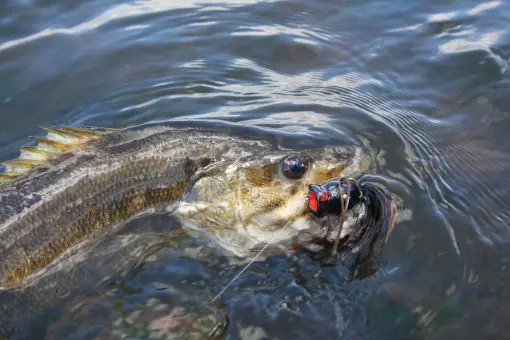
Consider The Water Temperature
Another important factor to consider when trying to find the right depth for bass fishing is the temperature of the water.
Bass are cold-blooded animals. This means they cannot regulate their own body temperature and must rely on external measures to keep their body temperature at the optimum level.
Water is a good conductor of heat and a poor conductor of cold. This means that when the temperature outside the water is cold, the fish will retreat deeper to find water that is insulated from the colder temperatures and regular their body heat.
When the air outside the water is hot, the heat is transferred through the water, which means the fish will again swim deeper than usual to self-regulate.
This also means that bass will move between areas of sun and shadow and areas of deep and shallow water in an attempt to regulate their bodies. This is part of the reason why it is so difficult to catch bass some days.
If the water temperature is neither too hot nor too cold, bass tend to live in the mid-water, as this is where the water temperature is at its most optimal for the fish.
All of this means that if you are fishing on a very hot or very cold day, fish deeper than usual. If you are fishing on a hot day, fish in the shadows. If you are fishing on a cold day, fish in the sunlight.
If you are fishing on a temperate day, the fish could be exactly where you expect them to be, and they may venture into shallower water.
One thing is for sure, you must develop a good intuition regarding the weather and water temperature when bass fishing, especially if you want to catch the largest bass possible.
Look For Baitfish and Other Prey
Another good way to determine the ideal depth for fishing for bass is to look for prey items and baitfish that the bass may hunt. Bass are all about food, and they are more likely to be where they can get something to eat than anywhere else.
Bass can change their depth if they need to look for food elsewhere, even if they are not usually found at these depths. These fish are very fast and can move between areas of water whenever they need to, so long as they have food to maintain their bodies.
For this reason, if you are fishing for bass and looking for the right depth, keep your eyes open for schools of baitfish or any other prey items that the bass may look for.
If you find a large group of bluegills, shiners, or even minnows, there is a good chance that you will find bass swimming at the same depth and actively hunting.
This is an ideal opportunity to gauge the depth of the bass and to even catch some bait fish to help you catch them.
Fish at the same depth as you find the prey item, and you are very likely to hook a bass.
The size of the prey will usually determine the size of the bass you find, so if you find some larger baitfish, such as bluegill, you are sure to find a larger bass in the same area and at the same depth.
If you are not finding bass anywhere, simply look for bass food. This is where you will find the bass, regardless of the depth.
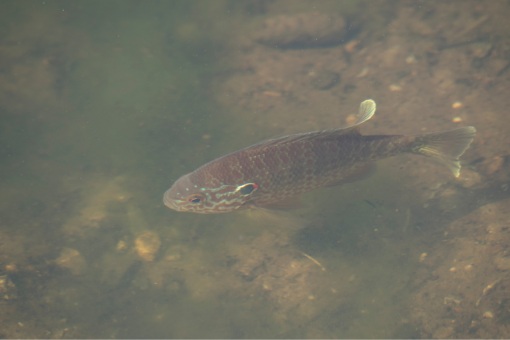
Never Fish Much Deeper Than The Mid-Point
Another good general rule to keep in mind when bass fishing is to never fish much deeper than the mid-depth of the water.
Bass rarely spends much time below the mid-level of the water, as there is very little food for them to eat past that point, and they may well get eaten by even larger fish, such as very large catfish or even very large trout.
The water temperatures, environment, and lack of prey below the mid-depth of the water is not conducive for bass, and so they are very rarely found at this depth unless they are particularly large and have followed a larger prey item to this depth.
However, this is only true if the water is deeper than 20+ feet. If the water is only around 15 feet deep, you may well find bass at the bottom, depending on the season and the availability of food.
If the water is shallower than 15 feet, bass will be found at every depth. This water is ideal for bass, and they are very easy to find regardless of the depth when fishing these waters, especially in ponds.
What Depth Do Bass Usually Swim At?
A commonly asked question regarding bass fishing is what depth bass can most often be found at to give beginner bass anglers a good starting point to fish from.
The truth is that most bass swim between 6 – 8 feet deep, especially in temperate climates. Look for bass in this depth first unless you are looking for very big bass.
Smaller bass, especially males, can be consistently found at this depth. This is an ideal depth for regulating body temperature, looking for food, breeding, and finding shelter.
The larger of the species will almost always be deeper, but there are fewer of these fish available to catch.
This means that, statistically, you have the best chance of catching a bass between 6 and 8 feet below the water’s surface.
This is always the best starting point for bass fishing, regardless of the season, the time of year, the time of day, and the type of water you are fishing in.
Only fish deeper if it is dusk or dawn, and only if the weather is very hot or very cold.
What To Do If No Depth Is Working For Bass
There are situations when every depth you try is to much work for finding bass. In these circumstances, there are only a few options to try and find them.
The best thing to do if you are not finding bass at any depth is to move on to a new area and look for prey items that may attract bass. If you find bass food, you are far more likely to find bass.
Other things you can try are to wait for dusk and try again, as this is when bass are most active. You can also look for areas where the bass may be, including areas of vegetation or areas with objects under the water, providing hiding places for the bass.
If nothing else works, you can always try attracting the fish to you by using bait. Use commercial bait, table scraps, chicken livers, a cup of worms, or even some floating bait such as rabbit food to attract the fish to your area or to a depth where you can more easily catch them.
This works especially well on very temperate days, on days that the fish may be very hungry, during spawning season, during the summer, or when it is raining. These are all times when bass tend to be more active and more ready for taking food.
If nothing works, it may be better to try again the next day or make adjustments to your gear, rig, or technique. On some rare occasions, there may be no bass in the area to catch. In this case, you may need to move on to somewhere else to get a bite.
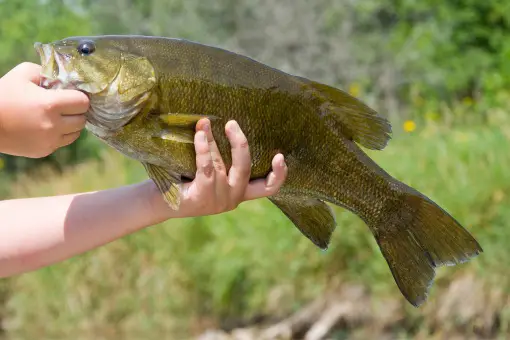
Conclusion
Bass is found at various depths, depending on many factors, but it is always best to look for bass between 6 – 8 feet down if you do not mind what size fish you catch. Bass can be much deeper or lower than this, but this is a good starting point.
- Do You Need An Indicator For Nymph Fishing? - November 16, 2023
- Fishing Safety Tips For Families - September 25, 2023
- What Is The Best Time To Night Fish At A Lake? - September 18, 2023

